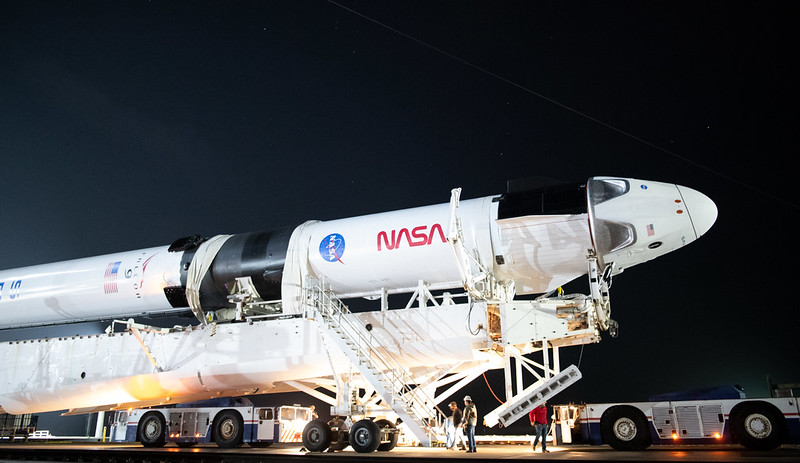SpaceX Crew Dragon rolls out to pad for Crew-1 astronaut launch for NASA

The SpaceX Crew Dragon capsule that will carry four astronauts to the International Space Station this weekend has made it to the launch pad.
The capsule, named Resilience, and its SpaceX Falcon 9 rocket rolled out to Launch Pad 39A at NASA's Kennedy Space Center in Florida late Monday into early Tuesday (Nov. 9-10), NASA officials said.
The Falcon 9 is scheduled to launch Saturday evening (Nov. 14), sending four astronauts — NASA's Victor Glover, Mike Hopkins and Shannon Walker and Japan's Soichi Noguchi — to the orbiting lab on Crew-1, SpaceX's first operational astronaut mission for NASA.
Live updates: SpaceX's Crew-1 astronaut launch for NASA
Some important boxes need to be ticked before that can happen, however. Two of those milestones will occur today (Nov. 10), if all goes according to plan — a "static fire" of the Falcon 9, in which the rocket's engines blaze up while the booster remains tethered to the ground, and completion of the Crew-1 flight readiness review. (Update for 2:50 p.m. EST on Nov. 10: The flight readiness review is done, and launch remains targeted for Nov. 14.)
NASA's Commercial Crew Program awarded SpaceX a $2.6 billion contract in 2014 to fly at least six operational crewed missions to the space station. The six-month-long Crew-1 is the first of those contracted flights, but it won't be SpaceX's first-ever astronaut mission. That distinction goes to Demo-2, a test flight that sent NASA astronauts Bob Behnken and Doug Hurley to the station for two months this past summer.
Crew Dragon and Falcon 9 in the hangar at Launch Complex 39A ahead of launching four astronauts to the @space_station; liftoff targeted for Saturday, November 14 at 7:49 p.m. EST pic.twitter.com/dlMrPUpr4dNovember 9, 2020
Boeing also got a NASA commercial crew deal in 2014, worth $4.2 billion. The aerospace giant will fulfill the deal using a capsule called CST-100 Starliner, which isn't ready to fly astronauts yet. Starliner must first ace an uncrewed test flight to the orbiting lab, a mission that the capsule first tried in December 2019. That attempt failed after a glitch trapped Starliner in an orbit too low to allow a meetup with the station.
Breaking space news, the latest updates on rocket launches, skywatching events and more!
Mike Wall is the author of "Out There" (Grand Central Publishing, 2018; illustrated by Karl Tate), a book about the search for alien life. Follow him on Twitter @michaeldwall. Follow us on Twitter @Spacedotcom or Facebook.

Michael Wall is a Senior Space Writer with Space.com and joined the team in 2010. He primarily covers exoplanets, spaceflight and military space, but has been known to dabble in the space art beat. His book about the search for alien life, "Out There," was published on Nov. 13, 2018. Before becoming a science writer, Michael worked as a herpetologist and wildlife biologist. He has a Ph.D. in evolutionary biology from the University of Sydney, Australia, a bachelor's degree from the University of Arizona, and a graduate certificate in science writing from the University of California, Santa Cruz. To find out what his latest project is, you can follow Michael on Twitter.

